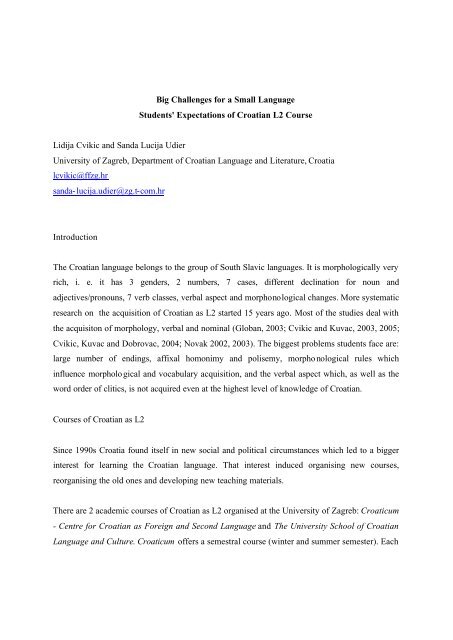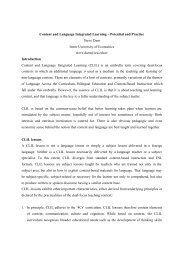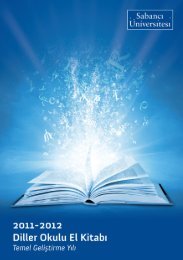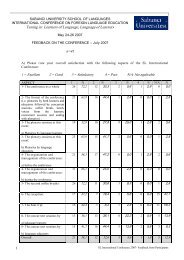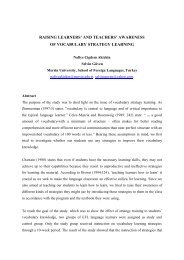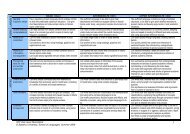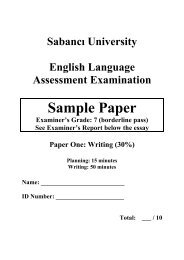Big Challenges for a Small Language - School of Languages
Big Challenges for a Small Language - School of Languages
Big Challenges for a Small Language - School of Languages
You also want an ePaper? Increase the reach of your titles
YUMPU automatically turns print PDFs into web optimized ePapers that Google loves.
<strong>Big</strong> <strong>Challenges</strong> <strong>for</strong> a <strong>Small</strong> <strong>Language</strong>Students' Expectations <strong>of</strong> Croatian L2 CourseLidija Cvikic and Sanda Lucija UdierUniversity <strong>of</strong> Zagreb, Department <strong>of</strong> Croatian <strong>Language</strong> and Literature, Croatialcvikic@ffzg.hrsanda-lucija.udier@zg.t-com.hrIntroductionThe Croatian language belongs to the group <strong>of</strong> South Slavic languages. It is morphologically veryrich, i. e. it has 3 genders, 2 numbers, 7 cases, different declination <strong>for</strong> noun andadjectives/pronouns, 7 verb classes, verbal aspect and morphonological changes. More systematicresearch on the acquisition <strong>of</strong> Croatian as L2 started 15 years ago. Most <strong>of</strong> the studies deal withthe acquisiton <strong>of</strong> morphology, verbal and nominal (Globan, 2003; Cvikic and Kuvac, 2003, 2005;Cvikic, Kuvac and Dobrovac, 2004; Novak 2002, 2003). The biggest problems students face are:large number <strong>of</strong> endings, affixal homonimy and polisemy, morpho nological rules whichinfluence morphological and vocabulary acquisition, and the verbal aspect which, as well as theword order <strong>of</strong> clitics, is not acquired even at the highest level <strong>of</strong> knowledge <strong>of</strong> Croatian.Courses <strong>of</strong> Croatian as L2Since 1990s Croatia found itself in new social and political circumstances which led to a biggerinterest <strong>for</strong> learning the Croatian language. That interest induced organising new courses,reorganising the old ones and developing new teaching materials.There are 2 academic courses <strong>of</strong> Croatian as L2 organised at the University <strong>of</strong> Zagreb: Croaticum- Centre <strong>for</strong> Croatian as Foreign and Second <strong>Language</strong> and The University <strong>School</strong> <strong>of</strong> Croatian<strong>Language</strong> and Culture. Croaticum <strong>of</strong>fers a semestral course (winter and summer semester). Each
course lasts 3.5 months, has 220 class periods in total (15 per week). Participants are divided into3 levels (beginner, intermediate and advanced), each with 2 sublevels. Groups contain up to 20students. University <strong>School</strong> is a 4 week summer course which includes 110 class periods in total(25 per week plus additional classes). Classes are organised in small groups (up to 12 students) at10 levels. Both courses <strong>of</strong>fer lectures on Croatian culture and teaching materials have beenspecifically developed <strong>for</strong> these courses.Needs analysisParticipantsThe research included 30 participants from each course who were given a questionnaire aboutpersonal data, educational background, language learning history, setting <strong>for</strong> usage <strong>of</strong> Croatian,detailed purpose <strong>of</strong> learning Croatian, content <strong>of</strong> the syllabus, learning styles and preferences <strong>for</strong>teaching methods.The structure <strong>of</strong> participants according to their knowledge <strong>of</strong> languages is: 6% speak only L1,27% speak one L2 and 67% speak 2 or more <strong>for</strong>eign languages. The purpose <strong>of</strong> learningCroatian: 52% <strong>of</strong> students learn Croatian <strong>for</strong> personal purposes, 15% <strong>for</strong> pr<strong>of</strong>essional, 17% <strong>for</strong>personal and pr<strong>of</strong>essional ones, 8% <strong>for</strong> study and 8% gave no answer to that question.According to the history <strong>of</strong> learning Croatian, participants can be divided into 4 groups: 37%learned Croatian in <strong>for</strong>mal settings, 25% in in<strong>for</strong>mal, 7% in both <strong>for</strong>mal and in<strong>for</strong>mal, 14%studied by themselves and 17% gave no answer.Content <strong>of</strong> Croatian L2 classesIn order to find out more about the preferred content <strong>of</strong> L2 classes 22 statements were <strong>of</strong>fered.Students used a five-point scale to express their preference (1 being the lowest and 5 being thehighest).According to the students' answers, the most preferred content <strong>of</strong> Croatian L2 classes is:• Croatian cultural features (37 students graded it with the highest grade),• Finding out about Croatian language (36 students),• Talking about habits, customs <strong>of</strong> people from other countries (27 students),• Talking about family and friends (26 students).On the other hand, the least preferred content in Croatian L2 class is:2
• Learning Glagolitic script (15 students graded it with the lowest grade),• Singing popular (13 students) and traditional songs (11 students),• Finding out about Glagolitic script (11 students).The results show that the most preferred content is language and cultural specifics as well as thetopics that are connected with everyday life. On the other hand, students do not like to learn socalled "academic content". The Glagolitic script is an old Slavic script that was used in thehistory <strong>of</strong> Croatian literature. Even though it is also highly culturally specific, it can be thatstudents perceive it as highly pr<strong>of</strong>essional-specific and demanding content. The fact that studentsexpressed high dislike to singing was to some extent unexpected.Since the two Croatian L2 courses are <strong>of</strong> the different length and intensity, and have differentsyllabuses, it was supposed that the preferred content depends on the language course itself.There<strong>for</strong>e, the data was analyzed according to the type <strong>of</strong> the course the subjects attended.Students at the Croaticum course prefer to find out about Croatian language (17 students gradedit with 5), they like to talk about education (15 students), listen to the radio (13 students) and talkabout movies, music and TV program (both was preferred the most by 13 students). Studentsattending University <strong>School</strong> like the most to find out about Croatian cultural features (21 studentsgraded it with 5), Croatian language (19 students), they like to learn how to use the phone (16students) and to talk about other cities and countries (16 students). Both groups <strong>of</strong> students listedthe same topics as the least preferred, although in different order.The difference in the listed preferred topics might be explained with the different structure <strong>of</strong> thecourse participants. The significant number <strong>of</strong> students at Croaticum course are the students from<strong>for</strong>eign universities who came to Croatia to master the language. Most <strong>of</strong> them are students <strong>of</strong>Slavic or Croatian studies. <strong>Small</strong>er percentage consists <strong>of</strong> students from the fields that requireknowledge <strong>of</strong> Croatian. That can explain their interest in the topic <strong>of</strong> education. Knowing the factthat most <strong>of</strong> them are in their 20s, it is not surprising that they are interested in music, movies andTV program.3
Students attending the University <strong>School</strong> make a more heterogeneous group. A significantnumber <strong>of</strong> them are from Croatian descent, others need to learn Croatian <strong>for</strong> pr<strong>of</strong>essional orvarious personal reasons. Their motivation to learn Croatian could explain their preference tolearn about cultural features.The aim <strong>of</strong> the questionnaire was to learn about students' preferred way <strong>of</strong> learning. 32 statementsabout various ways <strong>of</strong> learning were <strong>of</strong>fered. Participants used the same five point scale to showtheir preferences. The most learners graded the following statements with the highest grades:• I like the teacher to explain rules <strong>of</strong> grammar to me (36 students);• I like the teacher to explain new words to me (35 students);• I like the teacher to correct me immediately (30 students);• I like to know rules <strong>of</strong> sounds, word <strong>for</strong>ms and sentences (30 students).The least preferred ways <strong>of</strong> learning among the students were:• Correction in private (15 students);• Correction by other students (12 students),• Later correction (11 students),• Finding mistakes by themselves (9 students).From the students' answer it can be concluded that a teacher still plays the key role in the learningprocess. Students like very much when the teacher explains grammar and vocabulary and theywant to be corrected immediately. It seems that students don't like the learning/teaching processto take place outside the classroom. They do not like to be corrected later or in private and theydo not want other students to correct them or to find their mistakes by themselves.The researchers' assumption was that the preferred way <strong>of</strong> learning was influenced by theprevious language learning experience. There<strong>for</strong>e the data was analyzed according to the way thestudents had learned the Croatian language. The subjects were divided into 3 groups: group <strong>of</strong>students that had learned Croatian in <strong>for</strong>mal settings, in<strong>for</strong>mal settings and the students thatstudied themselves.4
The results show that learning style does not depend on the previous learning experience. All thestudents put the teacher at the first place. They prefer the teacher to explain grammar, meaning <strong>of</strong>words and their mistakes. Students who had learned Croatian in an in<strong>for</strong>mal setting or by selfstudyemphasized their interest to find out about word relationship. One possible explanation <strong>for</strong>that might lay in the fact that the most bilingual dictionaries, with Croatian being one <strong>of</strong> thelanguages, are written <strong>for</strong> native speakers <strong>of</strong> Croatian. There<strong>for</strong>e, Croatian L2 learners can notfind all the important or needed in<strong>for</strong>mation in these dictionaries, especially in<strong>for</strong>mation aboutusage constraints or differences between synonyms. A language teacher might be <strong>of</strong> great help inthat respect.When speaking about the least preferred ways <strong>of</strong> learning, the in<strong>for</strong>mal and self-study groupdiffer from "<strong>for</strong>mal group" only because they stated they do not like at all to work out the rules<strong>of</strong> grammar themselves. Since they have the experience <strong>of</strong> self-study, we could assume they areaware <strong>of</strong> the fact how difficult it is to find out grammar rules <strong>of</strong> the Croatian language bythemselves. That might be the reason they stated they do not like to do it at all. On the otherhand, the group <strong>of</strong> students that had been taught Croatian in a <strong>for</strong>mal setting do not like theteacher to make all the decisions about what they learn. It could be that a certain number <strong>of</strong>students have previous experience <strong>of</strong> attending a course where they were not active participantsin the decision making process.The students at both courses were asked about their preferred teaching and learning methods.The students like the most to learn by reading, listening, as well as listening and taking notes.They like to learn from written materials, TV, video and film. The students do not like to learn bymemory, from radio and by writing their own texts. Even though they did not choose anyparticular activity as the most preferred, they had chosen songs and memorized dialogs, i. e.conversation as the least useful activities.5
ConclusionCreating a general language course is a demanding task. If the language is a less commonlytaught, as it is with Croatian, it is even more complex to create a course curriculum since thestudents at such a course make a heterogeneous group. In order to create a Croatian languagecourse curriculum that will fit the students’ needs as much as possible, the needs analysis wasconducted. The analysis showed that the preferred language class content depends on the type <strong>of</strong>course participants, differentiating between university students and non-students. The courseparticipants that are students at <strong>for</strong>eign universities showed a reference to the topics connectedwith education, as well as <strong>for</strong> the topic that can be appealing to the young population (movies,TV, music). On the other hand, non-student population showed bigger interest in learning aboutCroatian cultural features. Culture-related topics <strong>for</strong> them mean only so called "everydayculture", not the culture related to history, art, literature etc. This result emphasized the need <strong>of</strong>developing the intercultural competence in learning L2. The subjects in our survey showed theinterest <strong>for</strong> learning about language structure. Since most <strong>of</strong> the course participants haveprevious experience <strong>of</strong> learning Croatian, which is a flective language, the interest in languagestructure is not surprising.Regarding the preferred ways <strong>of</strong> learning, the course participants showed that <strong>for</strong> them theteacher still plays the central role in the learning process and the preference <strong>for</strong> self-studying isquite low.Students also expressed their preference <strong>for</strong> teaching/learning methods. They like to learn byreading, and listening, they prefer to use written materials and multimedia. These methods werepreferred over role playing, language games and learning from personal experience.The conducted research gave us the insight in students' needs and preferences. It showed thatdifferent groups <strong>of</strong> students had interest in different topics. Knowledge <strong>of</strong> student needs andinterests enables language instructors to teach the same communication tasks, grammar units andvocabulary using various texts, i.e. discussing various topics. The survey showed that CroatianL2 students preferred traditional teaching. In this respect the real challenge is with language6
teachers. They have the opportunity not only to teach the language, but to show to their studentsthat there are some other teaching methods that can be equally effective but more dynamic andlearner-centered.7
REFERENCESCvikic, L. i Kuvac, J. (2005) The Acquisition <strong>of</strong> Croatian Masculine Noun Morphology inCroatian as Second <strong>Language</strong>. Proceedings from VII. International Conference <strong>of</strong> <strong>Language</strong>Examination, Applied and Medicinal Linguistics. Dunaujvaros, Hungary, 13-21.Cvikic, L. i Kuvac, J. (2003) Orši neljepo piše. Poteškoce djece, madarskih govornika,u ucenju hrvatskoga jezika.[Difficulties <strong>of</strong> children Hungarian L1 speakers, when learnigCroatian as L2] in: Vodopija I. (ed.) Zbornik sa strucno-znanstvenoga skupa Dijete i jezik,Sveucilišta J. J. Strossmayera i Visoke uciteljske škole, pp. 55- 66.Cvikic, L; Kuvac, J; Dobravac, G. (2004) The Acquisition <strong>of</strong> Croatian <strong>Language</strong> <strong>for</strong> Speakers <strong>of</strong>Roma <strong>Language</strong>s. 14 th EUROSLA. San Sebastian, Španjolska, 8.-11. 9., poster.Globan, N. Odstupanja na pocetnoj razini ucenja hrvatskoga kao stranoga jezika, Zagreb:Filoz<strong>of</strong>ski fakultet, diploma paper.Novak Milic, J. (2002) Ucenje glagolskih oblika u hrvtaskome kao stranome jeziku [Learning <strong>of</strong>verb <strong>for</strong>ms in Criatian as L2], Suvremena lingvistika, 53-54, 12-2, pp. 85-101.Novak Milic, J. (2002) Alibi za gramatiku (Utjecaj gramatickoga poucavanja na razvoj glagolskemorfologije u hrvatskome kao stranome ili drugome jezik u) [Influence <strong>of</strong> grammar teaching onthe acquisition <strong>of</strong> verbal morphology in Croatian as L2] in: Stolac, D. et al, Zbornik radovaHDPL, Zagreb-Rijeka, pp. 341-350.8


